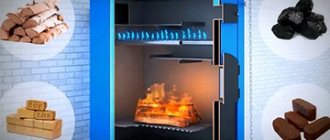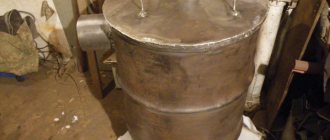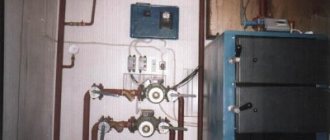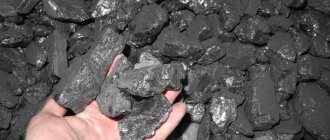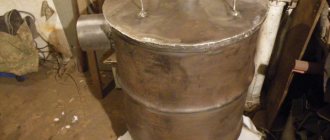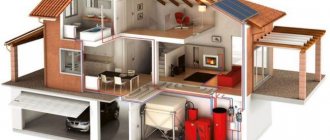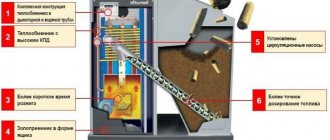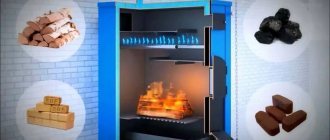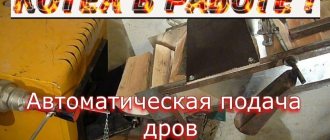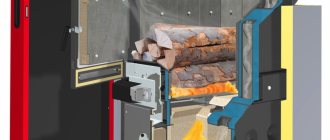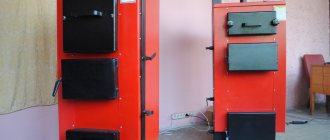Solid fuel heating boilers are an inexpensive option for heating and achieving comfort in your home. Because solid fuel (wood, coal, peat) is still the cheapest and most accessible type of fuel. For example, compared to diesel fuel and electricity, heating costs with solid fuel will be 2-5 times less. And this is a significant saving. Automated and economical boilers using solid fuel are successfully used in heating and hot water supply systems when there is no main gas. We offer you solid fuel boilers with maximum burning time. These are the latest generation models, best in their class and allowing you to create a heating system that is affordable.
| Economical • 3.6 times cheaper than electricity • 2.4 times cheaper than diesel fuel • 2.0 times cheaper than liquefied gas | Profitable • | Competent installation • Installation of the entire heating system • Installation of the boiler only • Supervised installation. Starting up an installed boiler • Warranty for equipment and work |
Sort:
Promotion!
-14%
Solid fuel boiler Metal-Fach SMART MINI 17 kW 42,999 RUR49,999 RUR
Promotion!
-10%
Solid fuel boiler Metal-Fach SMART OPTIMA 19 kW RUB 73,699 RUB 81,500
Solid fuel boiler Pelletron PROFI 50 129 990 RUR
Promotion!
-17%
Solid fuel boiler Metal-Fach SMART OPTIMA 32 kW RUB 92,899 RUB 112,499
Promotion!
-18%
Solid fuel boiler Metal-Fach SMART OPTIMA 50 kW RUB 115,099 RUB 140,500
Promotion!
-26%
Solid fuel boiler Metal-Fach SMART OPTIMA p/a 19 kW RUB 92,699 RUB 125,099
Promotion!
-21%
Solid fuel boiler Metal-Fach SMART OPTIMA p/a 32 kW RUB 111,899 RUB 141,499
Promotion!
-29%
Solid fuel boiler Metal-Fach SMART OPTIMA p/a 50 kW RUB 134,099 RUB 189,199
Promotion!
-9%
Solid fuel boiler Metal-Fach SMART MAXI 15 kW 81,099 RUR89,000 RUR
Promotion!
-6%
Solid fuel boiler Metal-Fach SMART MAXI 20 kW RUB 86,599 RUB 92,000
Promotion!
-8%
Solid fuel boiler Metal-Fach SMART MAXI 25 kW 90,099 RUR98,000 RUR
Promotion!
-15%
Solid fuel boiler Metal-Fach SMART MAXI 30 kW RUB 103,999 RUB 123,000
Promotion!
-14%
Solid fuel boiler Metal-Fach SMART MAXI 40 kW RUB 109,499 RUB 127,400
Promotion!
-13%
Solid fuel boiler Metal-Fach SMART MAXI 50 kW RUB 115,099 RUB 132,000
Promotion!
-6%
Solid fuel boiler Metal-Fach SMART MAXI p/a 15 kW 100,099 RUR106,000 RUR
Promotion!
-14%
Solid fuel boiler Metal-Fach SMART MAXI p/a 20 kW 105,599 RUR123,000 RUR
Promotion!
-15%
Solid fuel boiler Metal-Fach SMART MAXI p/a 25 kW 109,099 RUR128,000 RUR
Promotion!
-7%
Solid fuel boiler Metal-Fach SMART MAXI p/a 30 kW 122,999 RUR132,000 RUR
Promotion!
-9%
Solid fuel boiler Metal-Fach SMART MAXI p/a 40 kW RUB 128,499 RUB 141,000
Promotion!
-9%
Solid fuel boiler Metal-Fach SMART MAXI p/a 50 kW RUB 134,099 RUB 148,000
Semi-automatic solid fuel boiler AMTEO A 10 p/a 57,400 ₽
Semi-automatic solid fuel boiler AMTEO A 15 p/a 59,790 RUR
Semi-automatic solid fuel boiler AMTEO A 20 p/a 64,630 ₽
Semi-automatic solid fuel boiler AMTEO A 30 p/a 71,400 ₽
Semi-automatic solid fuel boiler AMTEO A 35 p/a 84,000 ₽
Semi-automatic solid fuel boiler AMTEO A 45 p/a 103,400 ₽
Semi-automatic solid fuel boiler AMTEO A 55 p/a 114,300 RUR
Semi-automatic solid fuel boiler AMTEO A 65 p/a 122,800 ₽
Solid fuel boiler AMTEO A 10 45 900 RUR
Solid fuel boiler AMTEO A 15 48 290 RUR
1
…
Popular types of wood briquettes
We have already talked about the production of fuel briquettes for heating boilers and furnaces, as well as their key advantages and disadvantages. It remains to figure out what types of briquettes are presented on the domestic market.
Fuel briquettes RUF
This fuel resembles white or wood-colored bricks in appearance (the shade varies widely). RUF briquettes are made from dry sawdust by pressing under high pressure. As a result, Euro-firewood is born, which can be used in any type of stove. Their distinctive feature is the inscription RUF, embossed on both sides.
RUF fuel briquettes for heating stoves are characterized by the release of a large amount of heat - they are almost one and a half times more profitable than firewood. They are easy to load combustion chambers and store them in stacks. Pressed bars are not afraid of moisture, but there is also no need to expose them to direct water. This fuel is supplied by many manufacturers - a typical example is. By the way, it also sells many other types of solid fuel.
Eurobriquettes PINI KAY
An interesting feature of these Eurobriquettes is their unusual shape - they resemble square pencils from which someone has taken the lead. That's why they are called "pencils". In order for it to burn with the release of a large amount of heat, a hole is made in it, increasing the draft. The “pencils” themselves look dark, as they were fired. This procedure makes them more durable and removes excess moisture.
The disadvantage of PINI KAY fuel briquettes for heating stoves is that they are more expensive than firewood and even more expensive than any other types of fuel. But they burn well, releasing a large amount of heat. They are also convenient to transport and store. Thanks to their shape, they are ideal for lighting fireplaces. Some people take them with them into the wild to use PINI KAY bars instead of wood for a fire.
Simple cylindrical briquettes
The simplest fuel briquettes for heating stoves are also on sale - in the form of cylinders. They are made from pressed sawdust and small wood waste. All this is pressed under slight pressure using a non-toxic adhesive base, after which the finished bars are sent to consumers. This fuel is cheap, but has one distinct drawback - low strength. It easily disintegrates and crumbles and does not withstand exposure to moisture.
Fuel briquettes from coal and peat
Peat and coal fuel briquettes for heating stoves are made from peat and coal, respectively. The starting materials are formed into small cylinders. The fuel can be used to light stoves and solid fuel boilers. Coal products give a high combustion temperature, but are characterized by high ash content. As for peat fuel, it is ideally suited for long-burning stoves, but it also produces a lot of ash.
If you have a stove that needs something to heat, we recommend that you use PINI KAY or RUF fuel briquettes. They are distinguished by their convenience and high calorific value, form a minimum of ash and provide long-lasting combustion.
Which is better: briquettes or firewood?
Often, modern elements for maintaining a flame are made from waste wood, but they have completely different characteristics than the familiar pieces of logs.
Aesthetic appearance and convenient storage are not all the advantages of such fuel. The heat from them is much less, which will require more time to heat rooms from “0” when compared with conventional firewood.
To save money
If we take into account the efficiency, the answer will be obvious; in order to constantly heat the house with such elements, you can purchase a budget version of the product. The cylindrical shape will be exactly this product; if the main goal is to save money, then I advise you to prepare such packs.
Some people have access to firewood at a low price, this applies to remote villages, but for people living in the suburbs of a metropolis, the price will not seem minimal. In this case, they cannot do without modern developments; trips to the forest and free cutting of trees can be punished by law, so a prudent person will not take risks and receive huge fines.
For heating
An alternative type of fuel will definitely be the best for heating in a solid fuel boiler, because the efficiency of any type of product exceeds logs quite significantly. People who are used to hearing the crackling sound of firewood may be upset, but if you think rationally, then Euro firewood will definitely pay for itself.
To achieve maximum results, I always recommend having wood and alternative burning elements available.
Especially if the equipment is old, but when the boiler is quite new and has a long-burning function, it will definitely be better, you should rely exclusively on European firewood.
There won’t be any particular problems with garbage, and in order to stock up on the required amount of fuel, you don’t need to make a lot of effort, you just need to go to the nearest warehouse to buy it.
Choosing a wood briquette boiler
Choosing a long-burning boiler using pressed wood briquettes can be difficult due to the large range of products offered. Models manufactured in Russia, European countries and neighboring countries are offered on the domestic market.
To facilitate the selection of equipment, all offered boilers for burning briquettes can be divided into several categories, based on territoriality - country of manufacture:
- Germany – Bosch Solid.
- Czech Republic - ATMOS, Dakon (the company is owned by Bosch), Wattek.
- Russia – Nibe Viking, Zharstal Dobrynya, Dragon.
- Türkiye – Radijator.
- Poland – Heiztechnik.
- Italy – Ferroli.
The proposed list contains boilers for burning briquettes using the principle of pyrolysis combustion. All models are always popular, as sales statistics clearly prove.
What is better to heat a boiler - with wood or briquettes?
A solid fuel boiler using wood briquettes, despite its good thermal performance, remains a rarity in most regions of Russia. But gradually the trends are changing.
To decide what to heat a solid fuel boiler with, wood or briquettes, it is worth considering what characteristics distinguish compressed fuel:
- Relative humidity – the indicator does not exceed 8-10%. Firewood, even after drying for two years, has a moisture content of at least 20%.
- Calorific value – varies at the level of 4.5-5 kW/kg. The same characteristics distinguish pellets and coal.
- Cost-effectiveness – the efficiency of a solid fuel pyrolysis boiler using wooden briquettes exceeds by 5.3% identical indicators when using coal.
The caloric content table for wood briquettes shows that compressed fuel is superior in its characteristics to ordinary wood. The constant use of stoves is economically beneficial and increases the battery life of solid fuel boilers.
By all indicators, the use of briquettes is more profitable. There are a few more parameters to consider:
- Technological results - combustion is characterized by stability and uniformity. With normal traction characteristics, the flame is bright yellow. During the combustion process, no soot is released. The chimney warms up quickly, there are no temperature changes. As a result of these features, a decrease in condensation is observed.
- Environmental characteristics – the emitted smoke is transparent. There is a sour smell. Combustion products do not contain harmful substances or soot that negatively affect human health.
- Production characteristics – briquettes make the work of service personnel easier. Even when using slabs in classic units, the operating time from one load increases to 8 hours. In pyrolysis or long-term combustion equipment, the time increases to 20 hours.
Taking into account all the characteristics, it is better to heat the boiler not with wood, but with briquettes.
The best long-burning solid fuel boilers
Zota Carbon
The lineup
This domestic series of long-burning solid fuel boilers is represented by models with power from 15 to 60 kW. The equipment is intended for heating residential and industrial buildings. The boiler is single-circuit and has the following coolant parameters: maximum pressure 3 bar; temperature from 65 to 95o C. With optimal settings, efficiency reaches 80%. The boiler is easy to load and has movable grates for ash removal.
Watch the product video
Design features
The boilers are completely energy independent. Control is carried out mechanically. There is protection against overheating of the coolant. A built-in heat exchanger made of high-quality steel is installed. The duration of the combustion process is regulated by changing the flow rate of air entering the combustion chamber.
A chimney with a diameter of 180 mm and pipelines of a 2” circulation circuit are connected to the device from the rear wall.
Fuel used. It is recommended to use coal of fraction 10-50 mm as fuel.
Candle
The lineup
The line of Lithuanian heating equipment Candle includes five long-burning boilers with a power from 18 to 50 kW. They are intended for floor installation in residential or industrial premises. The units are designed to operate autonomously as part of a separate heating system. There is no additional circuit for heating hot water. The device is designed for a pressure of 1.8 bar and a coolant temperature of 90o C.
Watch the product video
Design features
The design of the open-type firebox and automatic air supply adjustment provide for a long combustion mode. The water “jacket” is built into the boiler body. There is automatic protection against overheating. Flue gas outlet pipe 160 mm. The diameter of the circulation circuit fittings is 2”.
Fuel used. Firewood or peat briquettes can be used as fuel.
Stropuva S
The lineup
The line of single-circuit long-burning boilers made in Lithuania includes models with a power of 8, 15, 20, 30 and 40 kW. The buyer can easily choose a suitable unit for heating a private home or small business. The most productive of them is capable of maintaining optimal temperature in a building with an area of up to 300 sq.m. No electrical connection required.
During operation, the combustion zone smoothly shifts in the firebox from top to bottom. Efficiency reaches 91.6%. Maintenance consists of periodically replacing fuel, removing ash and periodically cleaning the gas path, including the chimney.
Watch the product video
Design features
The elongated upward shape of the housing saves usable space during installation. The volumetric firebox allows you to load up to 80 kg of fuel. Precise adjustment of the incoming air extends the burning time of one bookmark to 31 hours. The coolant is heated to 70°C and circulates at a pressure of up to 2 bar. On the rear side there are fittings for connecting a chimney with a diameter of 200 mm and heating water 1 ¼”.
Fuel used. The boiler is designed to use dry wood as the main source of energy.
Wood briquettes for the boiler
At the moment, the production technology has been changed. Consumers began to be offered cylindrical fuel, up to several centimeters long, which made it possible to use wood fuel briquettes in automatic boilers.
How and from what are wood briquettes made?
Heating wood briquettes for boilers are produced in three different ways, each of which has its own characteristics and markings:
- Rectangular RUF briquettes - received the marking due to the fact that the first compressed fuel was created on equipment manufactured by the German manufacturer RUF. In shape, the finished product resembles a small brick. The production principle is based on pressing sawdust and waste using hydraulic presses at a pressure of 300-400 bar.
Cylindrical briquette – pressing of briquettes for solid fuel boilers of this type is carried out using hydraulic or shock-mechanical equipment. When pressing, the pressure increases to 600 bar. The disadvantage of the cylindrical type of fuel is the fear of moisture and susceptibility to mechanical damage.
Pini&Kay – pressing of wood briquettes for heating boilers is carried out using mechanical screw equipment. The difference between production is the simultaneous use of high pressure (up to 1100 bar) and thermal firing. The resulting “logs” have edges and a characteristic dark brown color.
The washers are similar in structure to Pini&Kay, have four or six edges and a radial hole in the center. The length of the briquette is only a few centimeters.
The briquette production technology used affects the quality and cost of fuel. Pini&Kay have the highest calorific value; they are resistant to moisture and mechanical stress, and also burn longer when fired.
Briquette consumption in the boiler
Solid fuel for boilers in briquettes is made from various types of wood. The burning time and fuel consumption depend on the type and type of wood:
- Coniferous briquettes flare up quickly and create a high temperature in the firebox, but quickly burn out due to the large amount of resin released. Heating with pine briquettes is not profitable due to high fuel consumption, but it is advisable to use them to light the boiler.
- Pressed hardwood slabs have a high calorific value, are difficult to ignite and burn out slowly. The average consumption is 10 kg for 6-7 hours.
Another type of briquettes that has not found widespread use are slabs made exclusively from bark. This type of fuel burns hard, but during combustion it has practically no flame and smolders slowly. At the same time, the temperature is maintained until the slabs burn out. The average burning time is 12 hours.
Cost of wood briquettes
It is economically profitable to use fuel briquettes due to their high calorific value and low content of non-combustible residue.
How to properly heat with peat briquettes?
Let's try to figure out how to properly heat with peat briquettes? In order for the raw material to flare up, it needs a temperature of 150 degrees; in order to achieve it, you need to use a burning chip or a special ignition fluid.
It will take one day to find a comfortable temperature in the room. Light the stove, wait until it burns well and the room temperature reaches the desired level.
Flame from peat briquette
Then add a couple more briquettes, turn off the blower, and set the damper on the pipe to the minimum distance. In this mode the temperature will remain for a long time. They can be broken into smaller fragments and fired into the boiler.
What types of fuel briquettes are there?
Briquettes differ in shape and material of manufacture.
Differences in shape
There are three main forms of fuel briquettes: pini-kei, roof and nestro. Their difference is only in the maximum density that can be achieved in each form. There are no differences between European firewood in terms of chemical composition or mass calorific value.
Fuel briquettes pini-kay
The highest density is from 1.08 to 1.40 g/cm 3 . Section shape - square or hexagon. There is a through hole in the center, which provides better air movement and combustion of the briquette.
Fuel briquettes RUF
Fuel briquettes made from roof sawdust, in the form of a brick. They have a small size and the lowest density - 0.75-0.8 g/cm3.
Briquettes Nestro
Fuel briquettes have a non-stro cylinder shape and an average density of 1 - 1.15 g/cm3.
Peat briquettes
Peat fuel briquettes have a special shape, unlike others. And due to the high ash content and the presence of other harmful impurities in the composition, they are not recommended for use at home. Such briquettes are suitable for industrial furnaces or boilers that can operate on low-quality fuel.
Peat fuel briquette
Differences in material
Euro firewood is made from sawdust, seed husks, rice and buckwheat, straw, tyrsa, peat and other materials. The material affects the calorie content of the fuel briquette, ash content, amount of soot emitted, quality and completeness of combustion.
Below in the table is a comparison of the characteristics of briquettes made from different materials - seed husks, rice, straw, tyrsa and sawdust. Such an analysis shows not only that briquettes made from different materials differ from each other. But also the fact that even briquettes from the same material differ in quality and properties.
All data is taken from real test reports of fuel briquettes.
Calorie content, humidity, ash content and density of fuel briquettes made from different materials.
Comments on the table
Seed. The highest calorific value of briquettes made from sunflower seeds husks is 5151 kcal/kg. This is due to their low ash content (2.9-3.6%) and the presence of oil in the briquette, which burns and has energy value. On the other hand, due to the oil, such briquettes pollute the chimney more intensively with soot, and it has to be cleaned more often.
Tree. In second place in terms of caloric content are wood briquettes made from sawdust - 5043 kcal/kg at 4% humidity and 4341 kcal/kg at 10.3% humidity. The ash content of wood briquettes is the same as that of a whole tree - 0.5-2.5%.
Straw. Straw briquettes are not much inferior to sunflower seeds or sawdust and have good potential for use. They have a slightly lower calorie content - 4740 kcal/kg and 4097 kcal/kg, and a relatively high ash content - 4.8-7.3%.
Tyrsa. Tyrsa is a perennial herbaceous plant. Such briquettes have a fairly low ash content of 0.7% and good heat transfer of 4400 kcal/kg.
Rice. Briquettes made from rice husk have the highest ash content - 20% and low calorific value - 3458 kcal/kg. This is even less than wood at 20% humidity.
How to choose a good peat briquette?
When buying raw materials, do not trust the seller’s word regarding thermal conductivity, humidity, and ash content. Ask him for the relevant documents, test reports, which will indicate the characteristics of a specific batch of goods.
The raw materials should be as dense as possible, that is, not crumble in your hands, this will indicate low quality. And, as a result, it will burn out quickly and give off less heat.
Well, lastly, before purchasing a supply for the season, we recommend purchasing a small trial batch. Try to see what quality it is and, if everything suits you, only then buy a large volume.
Advantages of fuel briquettes
The main advantage of briquettes is that the combustion temperature is 1.5-2 times higher than that of firewood. At a humidity of 20%, the calorific value of wood is 2500-2700 kcal/kg, briquette - 4500-4900 kcal/kg.
And there are simple and logical explanations for this:
- Briquettes have low humidity. The lower the humidity of the firewood, the higher its heat transfer. Normal wood moisture content when properly stored is 15-20%. For briquettes, the humidity is 4-8% and is achieved through forced drying - a mandatory stage in their production.
- Briquettes have a high density
. Why does oak firewood burn hotter than poplar wood? Because of the density. The density of oak is 0.81 g/cm3, poplar is 0.4 g/cm3. That is, each cm3 of oak contains more useful and combustible woody matter than poplar. Briquette density is 0.95-1g/cm3. Their combustible content per unit volume is even higher than that of oak. Accordingly, the calorific value is higher.
Low humidity and high density are the key to the success of briquettes. If you dry firewood to a moisture content of 4-8%, then its calorific value will be comparable to briquettes.
Other advantages of briquettes:
- Take up less space.
- Burn more evenly and longer.
- Made from waste. If you care about the environment and the environment.
- Due to low humidity, briquettes emit less soot and pollute the chimney less.
- How to clean soot from a chimney? Simple ways to remove soot from a chimney at home.
- Does the firewood burn poorly and there is a burning smell in the room? Read these reasons for backdraft in a chimney.
Advantages and disadvantages of peat briquettes
The advantages include the following:
Peat briquettes
Flaws:
- This product is highly flammable. The storage location should be away from open flames. Dust that falls off it can also ignite very easily, be extremely careful and store them in a properly equipped room.
Two important conclusions
1. Different ash content
Two samples of straw briquettes have different ash contents - 4.86 and 7.3%.
Ash is mineral substances in wood that either have little energy value or simply do not burn. Therefore, the more ash in the wood, the less its heat transfer.
Different ash contents of fuel briquettes indicate different quality of production and source materials. One manufacturer does not clean the straw well enough to remove dirt and external ash. Another is adding foliage and other materials for volume. At the output, this greatly affects the quality, calorific value and burning time of the fuel briquette. And this situation can happen with any briquettes, not just straw.
2. Different humidity
The moisture content of the briquettes and their seed husks is 2.7% in one case, and 8.51% in the other. Some sawdust briquettes have a moisture content of 4.1%, while others have a moisture content of 10.3%.
This means that the humidity of fuel briquettes is also different. Their strength and calorific value depend on this: at a humidity of 4.1%, the heat transfer of a briquette is 5043 kcal/kg, and at 10% — 4341 kcal/kg.
Types of pellet boilers
Boilers differ according to the type of fuel used:
- pellet heating boiler - equipment that operates only on granulated raw materials;
- combined units can also operate on other types of raw materials, for example, sawdust.
Appliances can have burners of different designs; there are flare (in combination boilers) and retort types of burners. Devices with retort burners cannot be loaded with non-briquetted raw materials; the device will quickly fail.
Depending on the type of operation, there are automatic, semi-automatic and mechanical units. Automatic equipment is programmed only by professionals, semi-automatic equipment can be adjusted independently, and mechanical boilers require manual loading of fuel into the bunker compartment.
Peat boiler for home
A household solid fuel boiler that heats water by burning peat briquettes is designed in such a way as to ensure the best performance and calorific value, taking into account the specifics of fuel combustion. The unit operates in stages:
- Peat is fed into the furnace using a screw conveyor. Before this, the fuel is crushed using special equipment so that the fractions do not get stuck in the transmission.
- There is no standard horizontal grate; here it is installed at an angle.
- For the best thermal efficiency, the peat entering the grate is initially dried with warm air, which is heated in the afterburner.
- Small volatile peat particles ignite and thereby quickly heat the combustion chamber to the required temperature.
- The fuel ignites and burns in an intense combustion mode.
- In household models, a pyrolysis process occurs during intense combustion. Carbon dioxide, which is released during the combustion of peat, is afterburned in a special chamber. This makes it possible to obtain more heat energy.
If you plan to use peat as the main type of fuel, then it is advisable to buy a universal boiler that runs on peat, wood, briquettes, or convert a coal boiler.
The following models of heating units presented in the table are considered the most popular.
| Domestic production | Termofor, Retra, Lavoro (joint production of Italy and Russia) |
| Import production | Czech Dakon, Japanese Kentatsu, Lithuanian Aremikas Candle, Ukrainian Palche and ATON, Polish Galmet and SAS |
Almost all of the above manufacturers, in addition to household heating boilers, also produce industrial boilers that operate on peat briquettes and sod peat.
Construction of the Kholmov pyrolysis boiler.
Methods for storing briquette fuel
Pressed briquettes for heating must be stored in compliance with strict rules. It is necessary to monitor the humidity level in warehouses. Its indicator should not exceed 80%. For this there is no need to build insulated hangars. It is enough to update the roof over the canopy. Due to the fact that the fuel has a high density, a small area of the room allows you to store significant reserves of briquettes. One cubic meter can hold up to 2500 kilograms of fuel.
There is no need to equip warehouses with strict adherence to safety regulations, since the fuel in briquettes will not ignite. There is also no release of foreign gases or other toxic substances.
Fuel in briquettes does not absorb excess moisture, therefore it is able to maintain high performance for a long time.
Briquetted fuel has received excellent reviews and is widely used for heating suburban real estate, heating baths, saunas. Ideally keeps the air temperature at the specified values in fireplaces and stoves. It is also recommended to use it for heating greenhouses and outbuildings. This type of fuel can be used to light boilers for any purpose. As you can see, briquetted fuel is not only an economical, but also an effective source of heat.
Kindling the bath
Eurobriquettes are a universal fuel; they can be used to heat all types of stoves and boilers. They can be used in outdoor grills and home fireplaces. At the same time, the consumption of fuel briquettes is always significantly less than conventional firewood.
Many people are interested in whether it is possible to heat a stove with fuel briquettes if it is made of steel, like an ordinary heater? This question is quite logical, since such stoves have restrictions on the calorific value of the fuel; you cannot heat a steel sauna stove with black coal, which emits 4900 kcal/kg of heat. But in the case of Eurobriquettes, less heat is released, which means they can be used to heat a stove in a bathhouse.
For a bathhouse, not only the heat generated is important, but also the duration of burning of wood or alternative fuel. The longer the wood burns with maximum heat release, the better it is for the sauna stove and the sauna itself.
Whole package of fuel briquettes
Lighting fuel briquettes is not very easy, the fire does not catch immediately, but after they light up, they will burn and smolder for a couple of hours, which is much longer than the combustion of ordinary firewood. Such a long combustion time of fuel briquettes is explained by their high density and low humidity.
The large amount of heat generated and the long burnout time indicate that the consumption of fuel briquettes for heating a house is much less than that required for ordinary firewood.
Let us note that, according to people’s reviews, you should not completely fill the firebox of a sauna stove with Euro-wood, so as not to quickly reach the maximum heat transfer values.
An interesting point with Eurobriquettes is the residues left after their combustion. Having increased density characteristics, this fuel burns almost completely; it does not leave a large amount of ash, only a small pile of ash. Ash from fuel blocks smells unpleasant, but is an excellent fertilizer.
Good to know: Exclusive firewood holder “Harp” made of handmade solid wood
When Eurobriquettes burn, virtually no smoke is emitted, which is very valuable for maintaining the cleanliness of fireboxes, boilers, and chimneys. According to experts, linden fuel briquettes contain the least amount of resin, so when using such fuel, chimneys and boiler nozzles suffer the least.
Combustion of Eurobriquettes in the furnace furnace
Fuel briquettes are an excellent option for lighting a black sauna. As we have already said, this fuel is environmentally friendly, does not emit smoke, provides enough heat, and phytoncides appear in the heated air, which have a beneficial effect on the human body and improve immunity. Using the same linden eurobriquettes, you will feel how your body is healing, inhaling the pleasant aromas of flowers, honey and trees.
Of course, there is also a drawback to this type of fuel - it cannot quickly generate a lot of heat, it releases it gradually. As we have already said, the combustion is uniform, which, unlike firewood that flares up quickly and quickly dies out, allows you to easily maintain the same temperature.
Popular models
The modern market of heating units is overflowing with offers of highly efficient models of boilers operating on peat and peat briquettes. Let's note some of them.
The solid fuel peat boiler from the Ukrainian company Kliver is characterized by impeccable quality, 100% guarantee and high efficiency of up to 92%. It can operate on all types of solid fuel, including peat briquettes. They are used to heat large houses outside the city and industrial enterprises. Kliver is able to heat up to 300 m². The structure occupies only 0.5 m² and does not require a special room for installation. The approximate price of a Kliver with a power of 30 kW is 42,000 rubles.
Peat boiler Aremikas Candle S 18 kW
The Lithuanian boiler Aremikas Candle operates on peat briquettes and is used for heating individual housing construction, as well as for heating industrial premises. The price for Aremikas Candle with a power of about 20-35 kW is 120,000 rubles.
The Czech model Dakon DOR F12 is independent of electricity and has a power of 13.5 kW. It is characterized by a unique new design, an improved mechanism that holds the firebox door, and the absence of a top facing cover for easier fuel loading. Price - about 60,000 rubles.
Technological processes for the combustion of biological fuel are developing every day, peat has excellent consumer qualities, so this fuel is highly valued by scientists and specialists. The extraction and use of peat is considered the most promising direction for energy development in the future.
